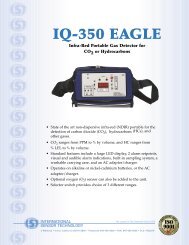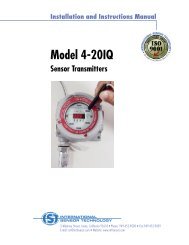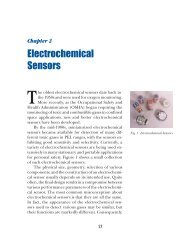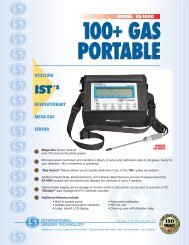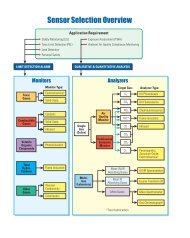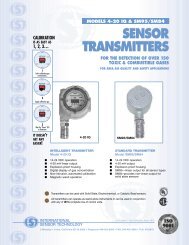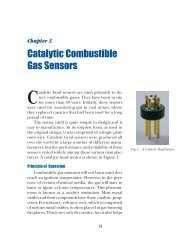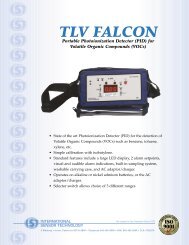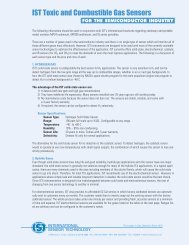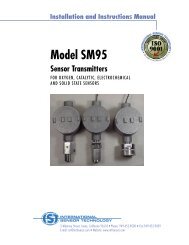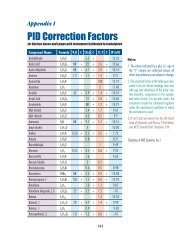Solid-State Gas Sensors - International Sensor Technology
Solid-State Gas Sensors - International Sensor Technology
Solid-State Gas Sensors - International Sensor Technology
Create successful ePaper yourself
Turn your PDF publications into a flip-book with our unique Google optimized e-Paper software.
Chapter 4<strong>Solid</strong>-<strong>State</strong> <strong>Gas</strong> <strong><strong>Sensor</strong>s</strong>Chapter 4<strong>Solid</strong>-<strong>State</strong> <strong>Gas</strong> <strong><strong>Sensor</strong>s</strong>When scientists were doing research work relatedto semiconductor p-n junctions, 1 theydiscovered that these junctions were sensitiveto environmental background gases.At that time, such a behavior was considered aproblem. This problem, however, was solved by encapsulatingthe semiconductor chip so that it was nolonger exposed to the outside environment. Subsequently,unsuccessful attempts were made to utilizethe sensitivity of the semiconductor junction as a gasdetection device.It wasn’t until 1968 that Mr. N. Taguchi marketeda simple semiconductor, or a solid-state sensor, for thedetection of hydrocarbons in LEL combustible ranges.The intention was to provide an alternative to thepopular catalytic bead sensor, which suffered fromseveral problems, including loss of sensitivity with timedue to poisoning and burning out when exposed tohigh gas concentrations.In 1972, <strong>International</strong> <strong>Sensor</strong> <strong>Technology</strong> (IST) inIrvine, California introduced a solid-state sensor forthe detection of hydrogen sulfide in a range of 0-10ppm. A few years later, IST developed solid-state sensorsfor the detection of more than 100 different hazardousgases at low ppm levels. This was a significantdevelopment, since OSHA was being formed at aboutFig. 1 A solid-state sensorused for detecting more than ahundred toxic gases.1The positive and negative junctionsin a semiconductor.47
Hazardous <strong>Gas</strong> Monitorsthe same time and began to regulate acceptable gasconcentration levels for safety at the workplace.Today, solid-state sensors are available for the detectionof more than 150 different gases, includingsensors for the gases which could otherwise only bedetected using expensive analytical instruments.There are now several manufacturers of solid-statesensors, but each sensor has different characteristicsand different manufacturers offer different levels ofperformance and quality.Properly manufactured, solid-state sensors offer avery long life expectancy. It is not unusual to find fullyfunctional sensors that were installed 30 years ago.The Rise in Popular Use of <strong>Solid</strong>-<strong>State</strong> <strong><strong>Sensor</strong>s</strong>. Inthe early 1980s, Japan passed a law that required gasdetectors to be installed in residential apartmentswhere gas bottles were being used. For this huge market,the competition was between solid-state and catalyticbead sensors.While there were some initial complaints aboutsolid-state sensors that produced false alarms, this wasfar outweighed by the long life the sensor provided.Because catalytic sensors burn the gas being detected,sensor material is consumed and changed in the processand the sensor eventually burns out.With solid-state sensors, on the other hand, gassimply “adsorbs” onto the sensor surface, changingthe resistance of the sensor material. When the gasdisappears, the sensor returns to its original condition.No sensor material is consumed in the process,and hence the solid-state sensors offer a long life expectancy.After a few years of usage, the catalytic sensors hadbecome less popular for such applications due to theneed for frequent sensor replacement.Principle of OperationA solid-state sensor consists of one or more metal48
Chapter 4<strong>Solid</strong>-<strong>State</strong> <strong>Gas</strong> <strong><strong>Sensor</strong>s</strong>oxides from the transition metals, such as tin oxide,aluminum oxide, etc. These metal oxides are preparedand processed into a paste which is used to form abead-type sensor. Alternatively, thick or thin film-chipsensors are made when the metal oxides are vacuumdeposited onto a silica chip, in a fashion similar tomaking semiconductors.A heating element is used to regulate the sensortemperature, since the finished sensors exhibitdifferent gas response characteristics at differenttemperature ranges. This heating element can be aplatinum or platinum alloy wire, a resistive metaloxide, or a thin layer of deposited platinum. Thesensor is then processed at a specific high temperaturewhich determines the specific characteristicsof the finished sensor.In the presence of gas, the metal oxide causes thegas to dissociate into charged ions or complexeswhich results in the transfer of electrons. The builtinheater, which heats the metal oxide material to anoperational temperature range that is optimal for thegas to be detected, is regulated and controlled by aspecific circuit.A pair of biased electrodes are imbedded into themetal oxide to measure its conductivity change. Thechanges in the conductivity of the sensor resultingfrom the interaction with the gas moleculesis measured as a signal. Typically,a solid-state sensor produces a verystrong signal, especially at high gas concentrations.There are different ways of makingsolid-state sensors, each arrangementmaking the sensor’s performancecharacteristics different. Two typicalstyles are the following:1. Bead-type sensor (Figure 2)2. Chip-type sensor (Figure 3, next page)49PlatinumCoil HeaterHeaterControlCollectorV OUTFig. 2. Schematic Diagram of a Bead-type <strong>Sensor</strong>
Hazardous <strong>Gas</strong> MonitorsTerminationCollectorHeater ResistorFig. 3 Chip-type <strong>Sensor</strong>Most solid-state sensors have threeor four pins, depending on how theheater and bias electrodes are connected.Characteristics<strong>Solid</strong>-state sensors are among themost versatile of all sensors, as they detecta wide variety of gases, and can beused in many different applications. Differentresponse characteristics are achieved by varyingthe semiconductor materials, processing techniques,and sensor operating temperature.Among the unique attributes of the solid-state sensorare the abilities of the sensor to detect both lowppm levels of gases, as well as high combustible levels.Longevity. The main strength of the solid-statesensor is its long life expectancy, as the sensor typicallylasts 10 years or more in clean applications. Thisis a major advantage compared to other sensor types,such as catalytic bead or electrochemical sensors,which typically last only one to two years.However, while solid-state sensors have a longerlife expectancy, they are also more susceptible to interferencegases than the other types of sensors. Thus,in applications where other background gases arepresent, solid-state sensors may trigger false alarms.In certain instances, the interferences from othergases are minimized by using appropriate filtering materialsthat absorb all other gases except the gas to bedetected.For example, a solid-state sensor for monitoringcarbon monoxide and hydrogen can be equipped witha charcoal filter which eliminates the majority of interferinggases. This way the sensor performs very welland becomes very selective for those two gases.Versatility. The versatility of the solid-state sensorSilicon SubstrateTermination50
Chapter 4<strong>Solid</strong>-<strong>State</strong> <strong>Gas</strong> <strong><strong>Sensor</strong>s</strong>is one of its main advantages. For example, in chemicalplants, a gas monitoring system may involve themonitoring of many different gases and ranges, oreven the same gas with multiple ranges.Often, the lower ranges need to be monitored forcertain gases for toxic concentrations while simultaneously,the same gas needs to be monitored in thecombustible range for explosive concentrations.The solid-state sensor is capable of detecting gasin both ranges. This greatly simplifies the system designand maintenance required because it eliminatesor minimizes the use of multiple sensor technologieswhich must be designed and maintained differently.A list of gases that are detectable by using IST’ssolid-state sensors is shown in Table 1 (pages 52-53).The typical ppm ranges which are chosen arethree to five times the permissible exposure limitsfor an eight-hour work day or ranges that can bebased on the sensitivity as well as the interferencecharacteristic of the sensor, whichever is the mostpractical in an application.Typical Specificationsfor <strong>Solid</strong>-<strong>State</strong> <strong><strong>Sensor</strong>s</strong>*Accuracy: ±3% to 10% of full scaleResponse Time: T 80 ranges from 20seconds to 90 secondsTemperature Range: –20 o C to +50 o CHumidity: 5–9%Life Expectancy: 10+ yearsPower Consumption: Approx. 300mW*Actual specifications will vary depending ongas and range.51
Hazardous <strong>Gas</strong> MonitorsGASTable 1: IST ’s <strong>Solid</strong>-<strong>State</strong> <strong><strong>Sensor</strong>s</strong> <strong>Gas</strong> ListFULL-SCALE RANGELow ppmor higher LELAcetic Acid 100 —-Acetone 100 yesAcetonitrile 100 —-Acetylene 50 yesAcrolein(Acrylaldehyde) 50 —-Acrylic Acid 100 —-Acrylonitrile 50 yesAllyl Alcohol —- yesAllyl Chloride 200 —-Ammonia x50 yesAnisole 100 —-Arsenic Pentafluoride 5 —-Arsine 1 —-Benzene 50 yesBophenyl 50 yesBoron Trichloride 500 —-Boron Triflluoride 500 —-Bromine 20 —-Butadiene 50 yesButane 400 yesButanol 1000 yesButene —- yesButyl Acetate 100 yesCarbon Disulfide 50 —-Carbon Monoxide 50 yesCarbon Tetrachloride 50 —-Cellosolve acetate 100 —-Chlorine 10 —-Chlorine Dioxide 10 —-Chlorobutadiene —- yesChloroethanol 200 —-Chloroform 50 —-Chlorotrifluoroethylene —- yesCumene —- yesCyanogen Chloride 20 —-Cychlohexane 100 yesCyclopentane 50 —-GASFULL-SCALE RANGELow ppmor higher LELDeuteriumyesDiborane 10 —-Dibromoethane 50 —-Dibutylamine —- yesDichloroethane (EDC) 50 yesDichlorofluoroethane 100 —-Dichloropentadiene 50 —-Dichlorosilane 50 —-Diesel Fuel 50 yesDiethyl Benzene —- yesDiethyl Sulfide 10 —-Difluorochloroethane —- yesDifluoroethane (152A) —- yesDimethyl Ether —- yesDimethylamine (DMA) 20 —-Epichlorohydrin 50 —-Ethane 1000 —-Ethanol 200 yesEthyl Acetate 200 yesEthyl Benzene 200 yesEthyl Chloride 100 yesEthyl Ether 100 yesEthylene 100 yesEthylene Oxide 5 yesFluorine 20 —-Formaldehyde 15 —-Freon-11 1000 —-Freon-12 100 —-Freon-22 100 —-Freon-113 100 —-Freon-114 1000 —-Freon-123 1000 —Fuel Oil or Kerosene —- yes<strong>Gas</strong>oline 100 yesGermane 10 —-Heptane 1000 yesHexane 50 yes52
Chapter 4<strong>Solid</strong>-<strong>State</strong> <strong>Gas</strong> <strong><strong>Sensor</strong>s</strong>Table 1 (continued) : IST ’s <strong>Solid</strong>-<strong>State</strong> <strong><strong>Sensor</strong>s</strong> <strong>Gas</strong> ListFULL-SCALE RANGEFULL-SCALE RANGEGASLow ppm GASLow ppmor higher LELor higher LELHexane 100 yesHydrazine 5 —-Hydrogen 50 yesHydrogen Bromide 50 —-Hydrogen Chloride 50 —-Hydrogen Cyanide 20 —-Hydrogen Fluoride 20 —-Hydrogen Sulfide 5 yesIsobutane 1000 yesIsobutylene —- yesIsopentane 1000 —-Isoprene —- yesIsopropanol 200 yesJP4 1000 yesJP5 1000 yesMethane 100 yesMethanol 200 yesMethyl Acetate 30 —-Methyl Acrylate 60 —-Methyl Bromide 20 —-Methyl Butanol —- yesMethyl Cellosolve —- yesMethyl Chloride 100 yesMethyl Ethyl Ketone 100 yesMethyl Hydrazine 5 —-Methyl Isobutyl Ketone 200 yesMethyl Mercaptan 30 —-Methyl Methacrylate 100 yesMethyl-Tert Butyl Ether —- yesMethylene Chloride 20 yesMineral Spirits 200 yesMonochlorobenzene —- yesMonoethylamine 30 —-Morpholine 500 —-Naptha 1000 yesNatural <strong>Gas</strong> 1000 yesNitric Oxide 20 —-Nitrogen Dioxide 20 —-Nitrogen Trifluoride 50 —-Nonane 2000 —-Pentane 200 yesPerchloroethylene 200 —-Phenol 100 —-Phosgene 50 —-Phosphine 3 —-Phosphorus Oxychloride 200 —-Picoline —- yesPropane 100 yesPropylene 100 yesPropylene Oxide 100 yesSilane 10 —-Silicon Tetrachloride 1000 —-Silicon Tetrafluoride 1000 —-Styrene 200 yesSulfur Dioxide 50 —-Tetrahydrofuran 200 yesTetraline 100 —-Toluene 50 yesToluene Diisocyanate 15 —-Trichloroethane 50 —-Trichloroethylene 50 yesTriethylamine (TEA) 100 —-Trifluoroethanol 25 —-Trimethylamine (TMA) 50 —-Tungsten Hexafluoride 50 —-Turpentine —- yesVinyl Acetate 1000 yesVinyl Chloride 20 yesVinylidene Chloride 50 —-Xylene 100 —-53




